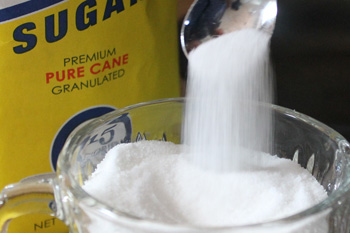The Big Brick Review
Building on the narrative of our lives...one brick at a time.

Sweet Tooth
by Sonja Livingston
“REMEMBER THE WAY you ate sugar right from the bowl?”Steph says. “You’d perch on a chair in your little kid underwear and toss back crystals with the shovel of a tiny spoon.”
Not the most flattering image—a child spooning sugar into her mouth while her belly hangs like a soft moon over her Day-of-the-Week underpants. But even as my sister conjures the memory and the image settles before us, part of me remains unashamed, for what is truer than the glint of sugar under kitchen light? No, I don’t necessarily remember the bowl or the spoon, but I know my sister is right the same way you can tell when night has arrived even in a room with no windows.
But the point here is sugar. How I ate it straight sometimes, how we used to cook it in winter when the potatoes were gone and the flour. How was it that we never ran out of sugar? There was always a bag of it sitting like a guardian on a shelf. Yellow with blue cursive lettering. The most solid things in that house: bags of sugar and a cast iron skillet.
“Stir it,” Steph said while the pan heated up, and the kitchen became the smell of hot metal. A year and a half older, my sister took charge, pouring a few cups of sugar into the pan, granules going soft as spent snow—how I longed to taste the syrupy slush but no, Steph said “no,” and “keep stirring” as she turned toward the cupboard, scaling a chair, hands moving behind tins of baking powder and packets of dry yeast, pushing aside boxes of instant pudding in flavors no one, no matter how hungry, had ever dared try—pistachio, for instance—finally coming away with a vial of food coloring, red or blue, color leftover from Easter or someone’s birthday cake.
Steph added a few drops of red to the skillet after the sugar moved from crumble to liquid and took the fork from my hand—regardless of how well or how poorly I stirred—my sister took that fork and told me to lay out wax paper and God help us there was hardly an onion in the cupboard but like magic, a roll of wax paper. I’d pull toward the line of silver teeth at just the right length.
The sugar was tinted by then. “Careful,”she’d say, holding the pan with a mitt, pouring the nectar onto the paper—how much I wanted to touch it, how it was as pretty to me as a wedding cake, that clear pink pond. But Steph knew best and allowed no touching until the sugar had hardened and we’d hammered it into shards that looked like stained glass lifted in splinters to our mouths.
Fried sugar, we called it. It stuck to the caps of our molars and was nowhere near as luxurious as caramel, not half as long-lasting as taffy, but it was sweet just the same, something to make with a long-haired sister on certain winter nights, a thing to count on when there was nothing else.
-----------------------
This essay originally appeared as part of a triptych in Connotation Press in spring 2014.
Sonja Livingston’s first book, Ghostbread (University of Georgia Press) won an AWP Book Prize for Nonfiction and is used in classrooms and reading groups around the nation. Another memoir, Queen of the Fall, is forthcoming in early 2015. Sonja’s writing has appeared in journals such as the Iowa Review, Seneca Review, Arts & Letters, and Creative Nonfiction and has earned a NYFA Fellowship, an Iowa Review Award, a Susan Atefat Essay Prize and other honors. Sonja splits her time between Rochester and Memphis, where she teaches in the MFA Program at the University of Memphis. For more, visit www.sonjalivingston.com.
"Sweet Tooth" photo © 2014 Gregory Gerard
Tweet < back to the Review.
